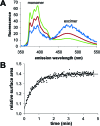RNA catalysis in model protocell vesicles
- PMID: 16173749
- PMCID: PMC5072289
- DOI: 10.1021/ja051784p
RNA catalysis in model protocell vesicles
Abstract
We are engaged in a long-term effort to synthesize chemical systems capable of Darwinian evolution, based on the encapsulation of self-replicating nucleic acids in self-replicating membrane vesicles. Here, we address the issue of the compatibility of these two replicating systems. Fatty acids form vesicles that are able to grow and divide, but vesicles composed solely of fatty acids are incompatible with the folding and activity of most ribozymes, because low concentrations of divalent cations (e.g., Mg(2+)) cause fatty acids to precipitate. Furthermore, vesicles that grow and divide must be permeable to the cations and substrates required for internal metabolism. We used a mixture of myristoleic acid and its glycerol monoester to construct vesicles that were Mg(2+)-tolerant and found that Mg(2+) cations can permeate the membrane and equilibrate within a few minutes. In vesicles encapsulating a hammerhead ribozyme, the addition of external Mg(2+) led to the activation and self-cleavage of the ribozyme molecules. Vesicles composed of these amphiphiles grew spontaneously through osmotically driven competition between vesicles, and further modification of the membrane composition allowed growth following mixed micelle addition. Our results show that membranes made from simple amphiphiles can form vesicles that are stable enough to retain encapsulated RNAs in the presence of divalent cations, yet dynamic enough to grow spontaneously and allow the passage of Mg(2+) and mononucleotides without specific macromolecular transporters. This combination of stability and dynamics is critical for building model protocells in the laboratory and may have been important for early cellular evolution.
Figures





Similar articles
-
RNA-Catalyzed RNA Ligation within Prebiotically Plausible Model Protocells.Chemistry. 2023 Aug 1;29(43):e202301376. doi: 10.1002/chem.202301376. Epub 2023 Jun 29. Chemistry. 2023. PMID: 37216492
-
Protocell Effects on RNA Folding, Function, and Evolution.Acc Chem Res. 2024 Aug 6;57(15):2058-2066. doi: 10.1021/acs.accounts.4c00174. Epub 2024 Jul 15. Acc Chem Res. 2024. PMID: 39005057 Free PMC article.
-
Coupled growth and division of model protocell membranes.J Am Chem Soc. 2009 Apr 22;131(15):5705-13. doi: 10.1021/ja900919c. J Am Chem Soc. 2009. PMID: 19323552 Free PMC article.
-
Crystallographic structures of the hammerhead ribozyme: relationship to ribozyme folding and catalysis.Annu Rev Biophys Biomol Struct. 1998;27:475-502. doi: 10.1146/annurev.biophys.27.1.475. Annu Rev Biophys Biomol Struct. 1998. PMID: 9646875 Review.
-
The origins of cellular life.Cold Spring Harb Perspect Biol. 2010 Sep;2(9):a002212. doi: 10.1101/cshperspect.a002212. Epub 2010 May 19. Cold Spring Harb Perspect Biol. 2010. PMID: 20484387 Free PMC article. Review.
Cited by
-
Measuring Vesicle Loading with Holographic Microscopy and Bulk Light Scattering.ACS Phys Chem Au. 2024 May 20;4(4):400-407. doi: 10.1021/acsphyschemau.4c00011. eCollection 2024 Jul 24. ACS Phys Chem Au. 2024. PMID: 39069977 Free PMC article.
-
From self-assembled vesicles to protocells.Cold Spring Harb Perspect Biol. 2010 Jul;2(7):a002170. doi: 10.1101/cshperspect.a002170. Epub 2010 Jun 2. Cold Spring Harb Perspect Biol. 2010. PMID: 20519344 Free PMC article. Review.
-
Oligomerization of a Bimolecular Ribozyme Modestly Rescues its Structural Defects that Disturb Interdomain Assembly to Form the Catalytic Site.J Mol Evol. 2018 Aug;86(7):431-442. doi: 10.1007/s00239-018-9862-8. Epub 2018 Aug 14. J Mol Evol. 2018. PMID: 30105586
-
Pulse-density modulation control of chemical oscillation far from equilibrium in a droplet open-reactor system.Nat Commun. 2016 Jan 20;7:10212. doi: 10.1038/ncomms10212. Nat Commun. 2016. PMID: 26786848 Free PMC article.
-
Artificial cells: from basic science to applications.Mater Today (Kidlington). 2016 Nov;19(9):516-532. doi: 10.1016/j.mattod.2016.02.020. Mater Today (Kidlington). 2016. PMID: 28077925 Free PMC article.

